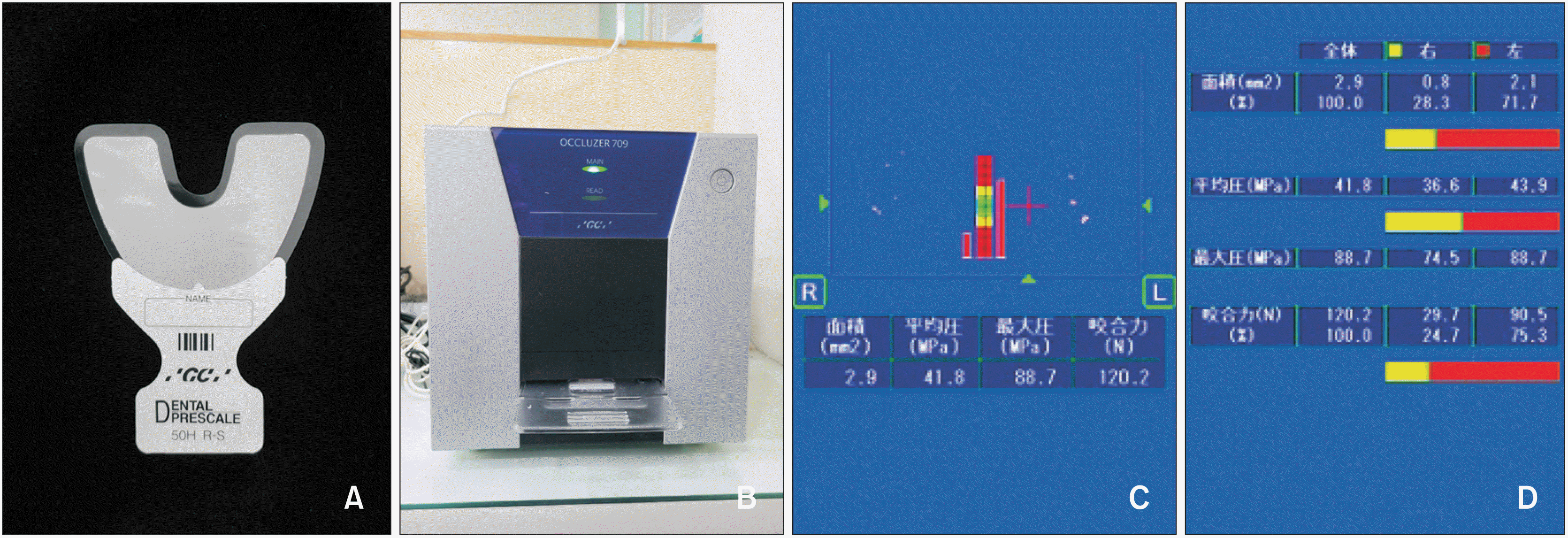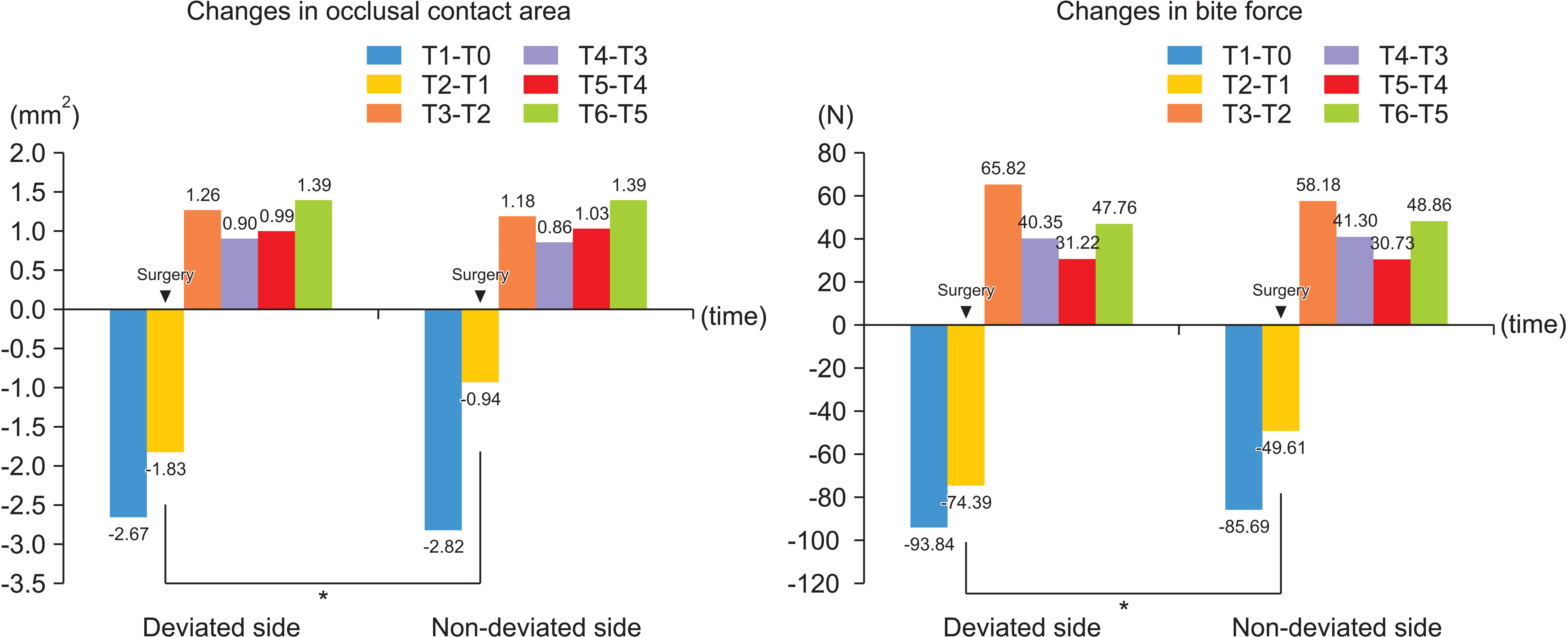INTRODUCTION
MATERIALS AND METHODS
Subjects
Measurements
 | Figure 1The Dental Prescale System (FujiFilm Corp., Tokyo, Japan). A, Pressure-sensitive sheet (50H, type R-L). B, The image scanner (Occluzer FPD-707). C, D, An example of the results of the bite force and occlusal contact area. The results are presented on the screen comparing the left and the right sides. |
Statistical analysis
Table 1
RESULTS
Table 2
| Measurements | Sides | T0 | T1 | T2 | T3 | T4 | T5 | T6 | p-value |
|---|---|---|---|---|---|---|---|---|---|
| Occlusal contact area (unit: mm2) | Deviated side | 5.61 (0.24) | 2.75 (0.25) | 0.89 (0.24) | 2.11 (0.24) | 3.01 (0.24) | 4.01 (0.24) | 5.32 (0.25) | 0.001** |
| A | BC | D | B | C | E | A | |||
| Non-deviated side | 4.61 (0.22) | 1.74 (0.23) | 0.83 (0.22) | 1.99 (0.22) | 2.86 (0.22) | 3.88 (0.22) | 5.26 (0.24) | 0.001** | |
| AB | C | D | C | E | B | A | |||
| Bite force (unit: N) | Deviated side | 219.02 (9.06) | 119.67 (9.54) | 44.50 (9.17) | 109.71 (9.11) | 150.02 (9.06) | 180.40 (9.17) | 225.53 (9.6) | 0.001** |
| A | BC | D | B | CE | E | A | |||
| Non-deviated side | 179.00 (8.71) | 92.59 (9.18) | 43.82 (8.82) | 101.17 (8.76) | 142.46 (8.71) | 172.86 (8.82) | 223.29 (9.25) | 0.001** | |
| A | B | C | B | D | AD | E |
T0, before treatment; T1, within 1 month before surgery; T2, T3, T4, T5, and T6 indicate 1, 3, 6, 12, and 24 months after surgery, respectively.
 | Figure 2Comparison of the occlusal contact area and bite force of the deviated side and non-deviated sides at each time point.
T0, before treatment; T1, 1 month before surgery; T2, T3, T4, T5, and T6 indicate 1, 3, 6, 12, and 24 months after surgery, respectively. The dashed line indicates the time when surgery was performed. The vertical bars indicate the 95% confidence intervals.
*p < 0.05; **p < 0.01.
|
Table 3
| Measurements | Sides | T0 (N = 67) | T1 (N = 59) | T2 (N = 65) | T3 (N = 66) | T4 (N = 67) | T5 (N = 65) | T6 (N = 58) |
|---|---|---|---|---|---|---|---|---|
|
Occlusal contact area (unit: mm2) |
Deviated side | 5.61 (0.42) | 2.75 (0.21) | 0.87 (0.08) | 2.13 (0.14) | 3.01 (0.17) | 4.02 (0.20) | 5.30 (0.30) |
| Non-deviated side | 4.61 (0.42) | 1.75 (0.17) | 0.82 (0.07) | 2.01 (0.11) | 2.86 (0.15) | 3.89 (0.18) | 5.26 (0.29) | |
| p-value | 0.001** | < 0.001*** | 0.420 | 0.199 | 0.232 | 0.353 | 0.813 | |
| Bite force (unit: N) | Deviated side | 218.92 (14.47) | 119.82 (9.07) | 44.44 (3.71) | 110.51(6.57) | 149.93 (7.01) | 180.72 (8.84) | 225.63 (11.20) |
| Non-deviated side | 178.99 (14.44) | 93.16 (7.45) | 43.93 (3.45) | 101.79 (6.11) | 142.46 (6.89) | 173.19 (8.43) | 223.48 (11.42) | |
| p-value | 0.001** | < 0.001*** | 0.862 | 0.037* | 0.133 | 0.343 | 0.767 |
 | Figure 3Comparison of the magnitudes of change in occlusal contact area and bite force of the deviated and non-deviated sides at each time point.
T0, before treatment; T1, 1 month before surgery; T2, T3, T4, T5, and T6 indicate 1, 3, 6, 12, and 24 months after surgery, respectively. The time indicated by an inverted triangle is when surgery was performed.
*p < 0.05.
|
Table 4
| Measurements | Period | T1-T0 | T2-T1 | T3-T2 | T4-T3 | T5-T4 | T6-T5 |
|---|---|---|---|---|---|---|---|
|
Occlusal contact area (unit: mm2) |
Deviated side | −2.67 (0.38) | −1.83 (0.22) | 1.26 (0.16) | 0.90 (0.12) | 0.99 (0.11) | 1.39 (0.17) |
| Non-deviated side | −2.82 (0.37) | −0.94 (0.19) | 1.18 (0.11) | 0.86 (0.11) | 1.03 (0.11) | 1.39 (0.17) | |
| p-value | 0.567 | < 0.001*** | 0.376 | 0.768 | 0.781 | 0.961 | |
| Bite force (unit: N) | Deviated side | −93.84 (12.51) | −74.39 (9.45) | 65.82 (6.28) | 40.35 (5.7) | 31.22 (6.19) | 47.76 (9.82) |
| Non-deviated side | −85.69 (12.52) | −49.61 (8.16) | 58.18 (5.34) | 41.30 (5.67) | 30.73 (5.88) | 48.86 (8.7) | |
| p-value | 0.402 | 0.001** | 0.104 | 0.862 | 0.943 | 0.932 |
Table 5
| Side | Variable | Bite force | Occlusal contact area | |||
|---|---|---|---|---|---|---|
| Univariable | Multivariable | Univariable | Multivariable | |||
| Deviated side | Occlusal contact area | < 0.0001*** | < 0.0001*** | - | - | |
| Bite force | - | - | < 0.0001*** | < 0.0001*** | ||
| Time | 0.0002*** | < 0.0001*** | 0.0702 | 0.0001*** | ||
| Sex | 0.2717 | 0.2141 | 0.6594 | 0.2482 | ||
| Age | 0.8673 | 0.2583 | 0.8752 | 0.4184 | ||
| Chin deviation | 0.2143 | 0.1882 | 0.5791 | 0.2831 | ||
| ΔSN-MP | 0.0089** | 0.0543 | 0.0603 | 0.3671 | ||
| ΔBody length | 0.2673 | 0.3411 | 0.5367 | 0.2337 | ||
| Non-deviated side | Occlusal contact area | < 0.0001*** | < 0.0001*** | - | - | |
| Bite force | - | - | < 0.0001*** | < 0.0001*** | ||
| Time | < 0.0001*** | < 0.0001*** | < 0.0001*** | 0.0102* | ||
| Sex | 0.0819 | 0.4609 | 0.1035 | 0.7949 | ||
| Age | 0.3981 | 0.3471 | 0.8063 | 0.2808 | ||
| Chin deviation | 0.2987 | 0.8710 | 0.4653 | 0.0867 | ||
| ΔSN-MP | 0.0407* | 0.0196* | 0.1356 | 0.7521 | ||
| ΔBody length | 0.0638 | 0.5186 | 0.1742 | 0.9495 | ||




 PDF
PDF Citation
Citation Print
Print



 XML Download
XML Download